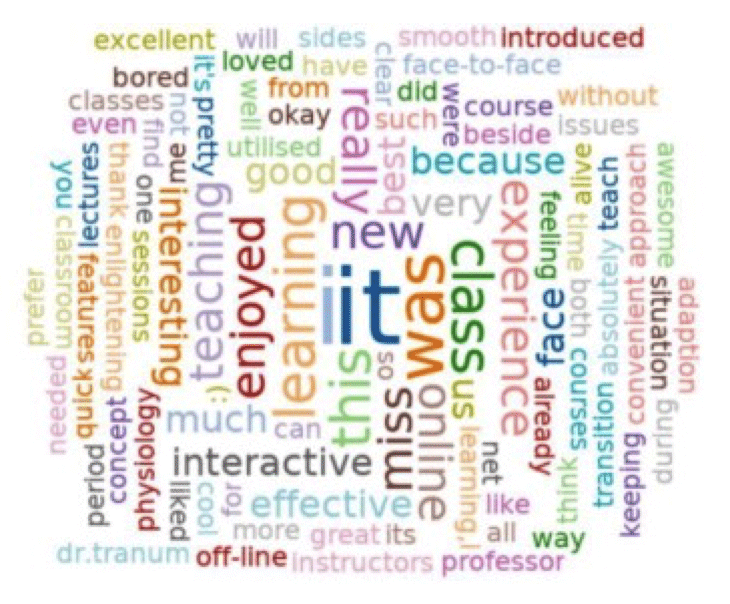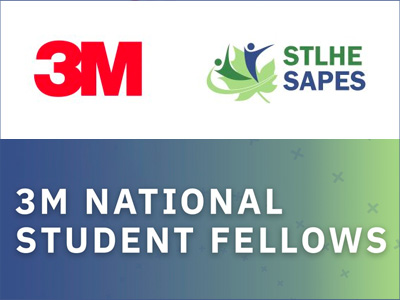“The technology itself is not transformative. It’s the school, the pedagogy, that is transformative.”
Tanya Byron
Starting Winter 2020, the pandemic transformed face-to-face teaching to hybrid, blended and/or flipped classrooms for many instructors. This triggered for me online course design and delivery keeping students in the forefront and as partners in learning. Mutlu G. and Yıldırım A. (2019) outline the importance of the classroom learning environment, and their data highlights teacher-supportive behaviors as the unique significant predictors of students’ persistence in learning (English as a Foreign Language learning in their case).
“Ethos of care” holds a special place in my teaching philosophy. I wondered how I could better connect, motivate and support students online at each and every step of their learning during these highly difficult, stressful and unprecedented times. Right off the bat, I gave special considerations to different time zones, especially for international students from different demographics. I was thoughtful of social privileges, from internet access and speed to study space access. This was followed by thoughtful preparation for synchronous and/or asynchronous course design and delivery. Overall, the following five strategies emerged as the top framework for technology driven online pedagogy of care:
- Setting the tone by creating a welcoming online learning environment: I begin my interaction in a positive tone by asking students to share a feeling emoji. I encourage them to start by sharing their feeling – let’s say a smiley face, and this sets the ball rolling on everyone’s feelings. This simple activity provides a glimpse about students’ lives. A simple care emoji works wonders! If you notice an anxious emoji, pause to provide support right away, or connect with the student individually after the class. I usually share upfront with students that lecture recordings can be reviewed at their own time and pace to ease anxiety, and assure them that it is going to be okay if they miss some or all of the live or synchronous interaction (that are being recorded) because of any reason, such as stormy weather disrupting their internet. In addition, for general technological concern, students can always contact IT help at their institution, or sometimes a simple restarting of the software, or logging out and back in, works well.
MMB Student feedback (Winter 2020): “Awesome, interactive! Thank you so much Professor for keeping us alive during this time period, Really needed it 😊.”

- Communicating respectful ground rules: Once a warm friendly classroom environment tone is set, I take a minute to clearly communicate code of conduct within a virtual classroom. The virtual classroom environment is premised on commitment to professionalism, respect for each other, honesty (maintaining academic integrity at all times) and respecting privacy, which is conducive to online learning. I remind everyone to share any concern or clarification verbally using the ‘raise your hand’ feature on Blackboard or via the chat. Students are encouraged to speak up and ask any questions they might have from the previous lecture, or from their asynchronous lecture recording during synchronous sessions.
BIOC 8700 course mid-term MMB Student feedback: “I absolutely love the way Dr Kaur is teaching us. I never feel pressurized/bored by studying her subject. It’s really good to listen to pre-recorded lectures and make our notes. Then we can easily catch her lectures and can ask our doubts during live sessions. Dr. Kaur is kind and always available through emails and office hours.”
For all my courses, I provide student academic honor code and pledge (as below), which students have to abide by in all fairness.
“I, student name _______, student ID ______ of _______program cohort verify that the submitted work, and/or assessments in this _____ term is my own, original work. I will adhere to all my Academic Rights and Responsibilities as defined in the Windsor Student Code of Conduct and will adhere to the academic integrity principles and rules defined in the Windsor Senate-ByLaw 31. This covers but is not limited to cheating, plagiarizing or misrepresenting the ideas of someone else, unauthorized assistance/collaboration, and falsifying data. As a student of the University of Windsor, I pledge to pursue all endeavors with honor and integrity, and will not tolerate or engage in academic or personal dishonesty. Signature: ________ Date: __________.”
Pedagogy of care involves thinking and planning what and when students will need ahead of time, and how you can, as an Instructor, support them in their learning. Important deadlines, weekly in-class engaging activities (e.g. break-out groups along the lines of think-pair-share), and weekly course topics are all communicated in the course syllabus. In addition, friendly reminders are shared both verbally in class and via announcement (one reminder is good enough) about the coming deadline or topics or recorded lectures posted ahead of time for flipped classrooms.
Compassion and empathy are important elements of pedagogy of care. One can start by putting yourself in students’ positions, or by recalling difficulties one faced in their student days. For example, a student could have an ailing family member to take care of, and this could have led to them missing an assignment deadline. As a course rule, I allow extended deadline submissions (24 to 48 hours) in consideration of online technological issues and/or personal challenges. Moreover, in case a student has missed a test or a quiz, I set up a time and date for a back-up quiz, which has helped many international students over the Fall 2020 Term. This simple plan provided security to some students so they felt like they wouldn’t miss any grades, and created a supportive learning environment.
- Creating a caring learning community by celebrating equity, inclusivity, diversity, and respect (EDIR): “Sense of belonging” is central to learning and is instrumental in constructing an inclusive, diverse, equitable and respectful caring space for students in their academic and social contexts (Walton & Brady, 2017). For all my courses, I include a statement in my course outline/syllabus on equity, inclusivity, diversity and respect:
“The University of Windsor and myself are committed to a respectful community and learning environment that embraces equity, diversity, and inclusivity including gender and gender-identity, sexuality, ethnicity, religion, culture, and national origins. This commitment is underscored by the University of Windsor being a signatory to the Dimensions Program and Charter. In this class I hold that each student has the right to be addressed in accordance with their personal identity (e.g., name, personal pro-nouns).1 I strongly believe our community and learning are enhanced and enriched when diverse perspectives and experiences are recognized and respected, and all are able to contribute.
1. University of Michigan, Center for Research on Teaching and Learning.”
This statement, along with my affirmation to support each student who wishes to self-identify, provides a sense of security and mental well-being in the learning community. Furthermore, I foster an equitable and inclusive learning environment by practicing culturally responsive pedagogy. In the Fall term 2020 BIOC 8700 Human Physiology course, I implemented an EDIR-based classroom activity where students shared their own cultural experiences with everyone, with the option of either submitting their cultural knowledge through Google Docs, or by verbally sharing their cultural experiences among peers. I was very pleased to see an overwhelming response to this activity, students developing an appreciation of diverse cross-cultures, and overall enhancing inclusivity.
- Availability and timely supportive resources: I am passionate in connecting with students and enjoy interacting with them individually. Over my 15 years as a University faculty member, I have maintained an “open door” policy. With this policy in an online environment, I have committed my availability to students 24/7 upon request (and my schedule permitting) in addition to my availability at the specified office hours. In my experience, this strengthens the bond between teacher and the student, and helps me to learn about student difficulty in order to provide timely support. Online team or Blackboard meetings allows face-to-face connection with students and allows me to direct them to the Leddy Library, International Student Center, or other available resources on campus, such as the Student Counselling Centre and the Wellness Outreach Office. In addition, I share with students online and IT technology resources with helpful studying online strategies: Online Learning Tips at UWindsor!
- Building an engaging online curriculum design and delivery: Positive learning environment is fostered with diverse instructional strategies utilizing Blackboard features such as discussion forum posts, polling (also available on Kahoot!, Mentimeter), chatting, break-out groups, team or group page with a number of optional tools such as a wiki, blog, journal, and more.
In the Fall term 2020 BIOC 8700 course, students could choose between either presentation (verbal format) or sharing the content using discussion post(s) (textual format). It gives students freedom to choose and provides multiple means of course delivery, and is in line with the universal design of learning (UDI).
Furthermore, literature supports regular low-stakes weekly quizzing as an instructional plan and as one of the best ways to help students retrieve knowledge from their memory and learn the subject material without procrastination. This concept is beautifully explained in the book “Make It Stick: The Science of Successful Learning” by Peter C. Brown, Henry L. Roediger III, and Mark A. McDaniel. I personally observed students favoring weekly quizzes over the Fall 2020 Term for BIOC 8700 Human Physiology and Mechanism of Disease course, as a way to revise and reflect on their learning. Weekly low-grade quizzes spread the weightage, and as per my personal experience created breathing room for everyone, and for this reason I am going to continue with this practice in Winter 2021.
Student feedback on weekly quizzes: “I am really liking the way Dr. Kaur is off-loading our study loads by taking quizzes every week.”
MMB student notes, “Course has been thoughtfully outlined with quizzes, discussions on the forum, poster, presentations making the course fun and interactive.”
MMB student notes, “Everything was perfectly designed and dated. which in turn helped us to concentrate more and prepare ahead of time.”
Salmon’s five stage model provides the structured framework for improving the social constructivist approach in e-learning (Salmon, 2014).

To break the physical distance monotony, I had created group assignments on purpose to bring everyone together for an engaging and interactive e-learning. In this group,assessment, a carefully crafted scaffolding approach was implemented whereby teams were asked to submit their work in three parts. Right after their first submission, a tailored feedback was provided in break out rooms which guided students for their second submission. The second submission support and feedback eventually led to their final and third submission. I feel this weaving of scaffolding and feedback had a powerful impact on students’ final project-based learning product. In addition to the personalized feedback provided by myself as the course Instructor, I encouraged students to hop between different break-out rooms to provide support and feedback to other teams on their project as well as learn from their peers’ work (as peer-scaffolding, Nabushawo, 2015) and become students as partners in learning. Finally, all teams showcased their work to an online global community at the end of the course.
In the end, I feel technology certainly enhanced scaffolding and contributed to meeting learning outcomes. However, it does need some due considerations and timelines. For example, I had kept a special session entirely for feedback while crafting my outline for this to work, and not overwhelm myself and the students (TIP: create a dedicated time/place/activity for providing feedback).
MMB Student feedback, BIOC 8700 online course: “The overall experience of doing the work on this presentation project was joyous for me as together we all learned something from each other like the presentation style, content finding ways, and interpretation of the results. Furthermore, now we are a small fraternity with comfortable with each other which enhances our harmony in terms of doing the projects in the future.”
MMB Student feedback, BIOC 8700 course: “I enjoyed this (online) semester very much and really learned a lot about group-work. Working in teams for a whole semester was a relatively new concept to me because my undergraduate classes did not really have this kind of group format.”
To sum it up, I find technology-driven pedagogy of care a highly transformative experience. At times, I find online delivery exhausting as it takes tremendous amount of planning, time and energy to create a caring and supportive pedagogy. This includes building lecture captions with MS-Stream and recording or re-recording my lectures (oops – did I just forget to unmute myself while recording) and to not miss my open-door policy. On the positive side, online learning brings a plethora of opportunities to connect with students, and keep them as caring partners in learning.
References:
Brown, P.C. (2014). Make it stick: the science of successful learning. Cambridge, Massachusetts The Belknap Press of Harvard University Press.
Crippen, K. J., & Archambault, L. (2012). Scaffolded inquiry-based instruction with technology: A signature pedagogy for STEM education. Computers in the Schools, 29(1–2), 157–173. http://doi.org/10.1080/07380569.2012.658733.
Salmon G, Wright P. (2014). Transforming Future Teaching through “Carpe Diem” Learning Design. Education Sciences. 4(1):52-63.
Mutlu G, Yıldırım A (2019). Learning Environment Perceptions and Student Background Variables as Determinants of Persistence in EFL Learning. SAGE Open. doi:10.1177/2158244019898805
Nabushawo (2015). Scaffolding Task 4.2.1. In. Moxnes et al. Assignment 4.2.1 – Scaffolding, DEADLINE 20.11.UIA.
Walton, G. M., & Brady, S. T. (2017). The many questions of belonging. In A. J. Elliot, C. S. Dweck, & D. S. Yeager (Eds.), Handbook of competence and motivation (2nd Edition): Theory and application (pp. 272–293). New York: Guilford Press.
Tranum Kaur is a faculty and Master of Medical Biotechnology (MMB) program coordinator at the Chemistry and Biochemistry Department, University of Windsor. She has been teaching undergraduate and graduate students since 2006. Dr. Kaur is a recipient of several prestigious awards including Excellence in Mentoring (2018), Roger Thibert Teaching Excellence (2017), and Dean of Science Recognition (2015) Award.










Comments